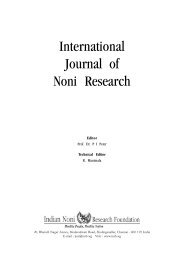International Journal of Noni Research - Noni Family
International Journal of Noni Research - Noni Family
International Journal of Noni Research - Noni Family
Create successful ePaper yourself
Turn your PDF publications into a flip-book with our unique Google optimized e-Paper software.
63 Intl. J. <strong>Noni</strong> Res. 2007, 2(1-2)<br />
citrifolia and M. pubesens. The chemical and biological properties <strong>of</strong> both the<br />
Morinda species were investigated and reported in this article.<br />
Materials and Methods<br />
Chemical properties<br />
Preparation <strong>of</strong> plant extracts <strong>of</strong> Morinda.<br />
The fruits <strong>of</strong> M. citrifolia were collected from the trees located in the coastal<br />
area <strong>of</strong> Seruthala in Kerala and M. pubescens fruits were obtained from the tree<br />
in the Botany Field <strong>Research</strong> Laboratory, University <strong>of</strong> Madras, Madhuravoyal,<br />
Chennai, Tamil Nadu. They were washed with tap water and rinsed with distilled<br />
water and air dried for 1 h. The fruits were ground to powder using pestle and<br />
mortar and stored at -20°C until use. For preparation <strong>of</strong> plant extracts, five<br />
different solvents viz., petroleum ether, ethyl acetate, chlor<strong>of</strong>orm, ethanol and<br />
water were mixed separately with the fruit powder at 2:1 ratio (w/v) and kept<br />
over night in shaken condition. These extracts were filtered through Whatman<br />
No.1 filter paper and dried in vacuuo and used for further studies.<br />
Protein estimation<br />
The protein content in the fruit extracts <strong>of</strong> M. citrifolia and M. pubescens was<br />
estimated by the standard dye binding method <strong>of</strong> Bradford (1976) using the<br />
following two different extraction procedures.<br />
1. Standard aqueous extraction<br />
2. Extraction using antioxidant<br />
The sugar, starch, lipid and crude fiber content in the fruits <strong>of</strong> M. citrifolia and<br />
M. pubescens was analyzed using standard methods.<br />
Elements<br />
The essential elements viz., Potassium, Calcium, Magnesium, Nitrogen,<br />
Phosphorus, Copper, Manganese, Zinc and Iron were estimated using Flame<br />
photometer, UV-Vis Spectrophotometer and Atomic Absorption<br />
Spectrophotometer (AAS).<br />
Antioxidative activity<br />
N. Mathivanan et al. Chemical and biological properties <strong>of</strong> Morinda spp.<br />
The lipid peroxidation levels in the fruit extracts <strong>of</strong> M. citrifolia and M.<br />
pubescens were estimated by FTC (and Namiki,1981) and TBA (, 1959; Kikuzaki<br />
and Nakatani, 1993) methods.<br />
Ferric thiocyanate (FTC) method<br />
The fruit samples <strong>of</strong> 4mg in 99.5% ethanol were mixed with 2.51% Linoleic acid<br />
in 99.5% ethanol (4.1 ml), 0.05 M phosphate buffer, pH 7.0 (8 ml) and








